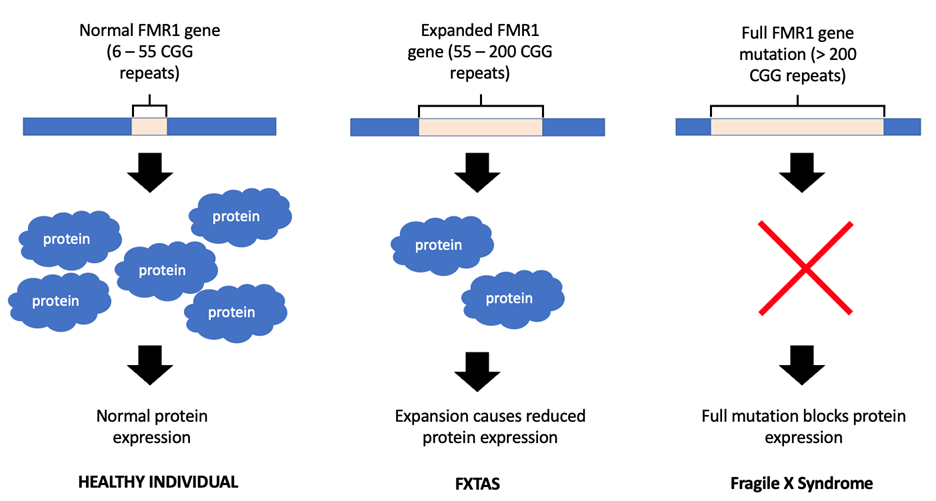
Fragile X-associated tremor/ataxia syndrome (FXTAS) is a neurodegenerative disease first described in 2001 that is caused by a mutation or change to a gene on the X chromosome.
The X chromosome is the section of DNA that determines biological sex. Biological females typically have two X chromosomes (one from their mother and one from their father). Biological males typically have one X chromosome (from their mother) and one Y chromosome (from their father).
FXTAS about affects 1/4000 males and 1/7000 females worldwide. People usually start experiencing symptoms when they are in their 40s – 50s. Patients with FXTAS experience impaired movement and develop ‘intention tremors’, which are uncontrolled shakes when intentionally moving. They also have cerebellar gait ataxia, which is clumsy, staggering, and uncoordinated walking. Advanced cases of the disease further show memory impairment and nervous system dysfunctions. Unfortunately, once symptoms present, life expectancy typically ranges from 5 to 25 years, and there are currently no treatments that target the root causes of the disease.
What causes Fragile X-associated tremor/ataxia syndrome?
This syndrome is triggered by a mutation in the fragile X messenger ribonucleoprotein 1 (FMR1) gene. The FMR1 gene encodes the fragile X messenger ribonucleoprotein (FMRP), which is associated with healthy female reproductive system function and normal brain development.
In healthy individuals, the FMR1 contains a small sequence of repeated DNA called cytosine-guanine-guanine (CGG) repeats. Healthy individuals carry 6 to 55 repeats, where as people at risk of developing FXTAS carry 55 to 200 cytosine-guanine-guanine repeats in their FMR1 gene.
People with more than 200 repeats have another neurological condition called Fragile X Syndrome (FXS). This repeated part of the gene is unstable and, when passed from a mother (on the X chromosome) to their child, may grow in the next generation. The expanded gene leads to reduced production of the corresponding protein (FMRP), causing disease, as shown in the figure below.

Figure 1: Mechanism of Fragile X-Associated Tremor/Ataxia Syndrome. Image created by Paige Chandran Blair.
While the exact way the expanded gene causes the disease is unknown, a leading theory suggests that the messenger RNA produced from the expanded gene accumulates and leads to toxicity.
Research has shown the size of the expansion correlates to the degree of damage to the brain, severity of tremors (shaking) and gait ataxia (impaired walking), and risk of developing cognitive impairments. Therefore, someone with 55 repeats is likely to develop a less severe disease than someone with 200 repeats in their FMR1 gene.
However, not all people with the expansion in their FMR1 gene will develop the disorder, but what triggers some individuals to develop the disease and what spares others is currently unknown.
While this condition does impact both males and females, scientists theorize that females are affected at lower rates with less severity due to a potential protective influence by the second X-chromosome. Notably, since this gene relates to reproductive health, females with the mutation may also be affected by another disease called fragile X-associated primary ovarian insufficiency. While very different from FXTAS, people with primary ovarian insufficiency typically have improperly functioning ovaries, infertility, and premature menopause.
Diagnosis & Treatment
Since there is a clear genetic cause, diagnosis of fragile-X associated tremor/ataxia syndrome usually involves a genetic test to determine the number of repeats in the FMR1 gene, assessment of symptoms consistent with FXTAS, and imaging of the brain.
Unfortunately, because the disease was only discovered in 2001, we do not know the exact way the disease occurs or why some people with the mutation have FXTAS but not others. Consequently, there are no known treatments to slow the progression or cure FXTAS, only to manage symptoms.
However, in recognition of the massive need for treatments, extensive research is currently ongoing to develop treatments that directly combat the root causes of disease or effectively alleviate symptoms. For example, a 2019 pilot study from a research group at the University of California Davis found that allopregnanolone, a natural neurosteroid, could improve some manifestations of FXTAS. Promising studies like these bring cutting-edge research to offer innovative solutions to combat FXTAS and potentially develop a cure.
If you would like to learn more about FXTAS, take a look at this article by the National Fragile X Foundation.
Snapshot Written by: Chandran Blair
Edited by: Dr. Larissa Nitschke

Snapshot: What is Spasticity?
Spasticity is a condition where muscles involuntarily stiffen, impeding normal smooth movements. Spasticity can present in varying severities with varying impacts on daily life. For example, minor spasticity resulting in Read More…


Snapshot: What is Articulation?
Articulation refers to the ability to produce speech sounds using the tongue, lips, jaw, and the roof of your mouth. All of these organs are also known as articulators. The Read More…


Snapshot: What is Resonance?
In speech-language pathology, the term resonance refers to nasality in speech. In other words, how nasal a person’s speech sounds. When someone is congested, they likely sound hyponasal, or not Read More…









